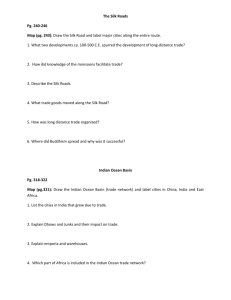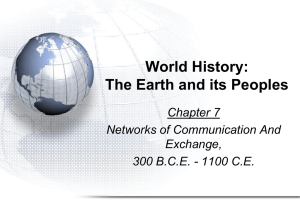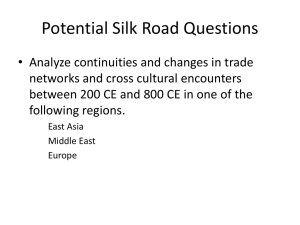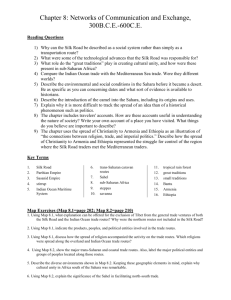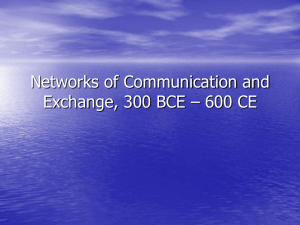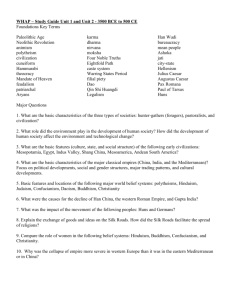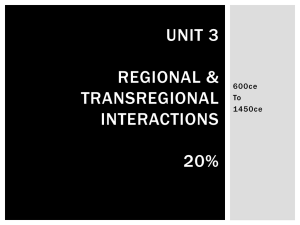Chapter 8 PP
advertisement
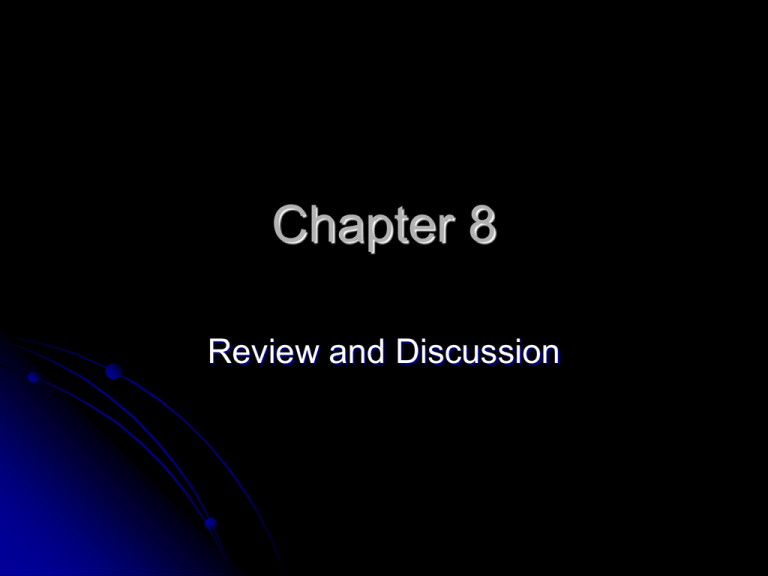
Chapter 8 Review and Discussion The Silk Road Connected China to the Mediterranean and drew together the different regions of Eurasia Route of the Overland Silk Road Linked China and the Holy Roman Empire The two extreme ends of Eurasia Started in the Han capital of Chang’an and went west to the Taklamakan Desert There the road split into two main branches that skirted the desert to the north and south Taklamakan Desert: “The Desert of Death” The Silk Roads avoided the Taklamakan Desert and passed through the oasis towns on its outskirts Organization of Long-distance Trade Individual merchants usually did not travel from one end of Eurasia to the other Instead they handled long-distance trade in stages Chinese, Parthians, Persians, Indians, Romans, and others would dominate the caravan or maritime trade routes within their empire or territory of influence Silk Road Trade to the West Silk and spices traveled west from southeast Asia, China, and India China was the only country in classical times where cultivators and weavers had developed techniques for producing high-quality silk fabrics Spices served not just to season food but also as drugs, anesthetics, aphrodisiacs, perfumes, aromatics, and magical potions Chinese silk making Silk Road Trade to the East Central Asia produced large, strong horses and jade that was highly prized by Chinese stone carvers The Roman empire traded glassware, jewelry, works of art, decorative items, perfumes, bronze goods, wool and linen textiles, pottery, iron tools, olive oil, wine, and gold and silver bullion Mediterranean merchants and manufacturers often imported raw materials such as uncut gemstones which they exported as finished products in the form of expensive jewelry and decorative items Hybrid Camel and Stirrup What were some of the technological advances that the Silk Road was responsible for? Agriculture Exchange of agricultural products led to diversifying people’s diet Advancement in Camel and horse breeding Hybrid camels (designed to overcome limitations of the road’s climate and length Warfare Stirrup (gave mounted troops enormous advantages over their opponents) Why can the Silk Road be described as a social system rather than simply as a transportation route? Exchange of ideas and cultures Evident in religion (Buddhism, Islam, Christianity, Zoroastrianism) affected both the peoples along the road and those far beyond. Was the silk road dominated by any state or culture? Because of its size and isolated nature, it was not dominated by any one culture or state. What impact did it have on the movement of people? trend toward moving from the countryside to the cities and trading centers thus fundamentally altering people’s lives. Spread of Disease The Antonine Plague (165-180 A. D.) was a plague of either smallpox or measles brought back to the Roman Empire by troops returning from campaigns in the Near East Roman emperor Marcus Aurelius Antoninus was among the victims The disease broke out again nine years later and the Roman historian Dio Cassius reported it caused up to 2,000 deaths a day at Rome Total deaths have been estimated at five million Indian Ocean Trade Indian Ocean Trade Indian Ocean has larger waves and the boats were more resilient than the ones used in the Mediterranean Sea. The traders learned how to understand the monsoon seasons and the direction of winds, and scheduled their voyages accordingly. Sailors often married women at the ends of their trade routes, cultures started to intermix rapidly. Many sailors took foreign wives home and Mediterranean Trade incapacitated sailors used square sails and long banks of oars to sail to the many islands and into small harbors. sailors were rarely out of sight of land traders also often established colonies to galvanize trade contacts Mediterranean basin was also smaller and more competitive because of a smaller number of goods— copper, tin, wine, olive oil, and pottery The competition sparked recurrent warfare and rivalry in the Mediterranean Compare the Indian Ocean trade with the Mediterranean Sea trade. Are they different worlds? Indian Ocean vessels used lateen (triangular) sails and rode the winds rather than using oarsmen. sailors sailed long distances entirely at sea. contacts were less frequent and therefore seldom resulted in political ties. Indian Ocean world was primarily concerned with population movements and the exchange of goods and ideas. the volume of goods in the Indian Ocean was lower than in the Mediterranean Sea, the trade in the Indian Ocean included a large variety of highly valued goods. Geography & Climate of Africa Varied climate zones and landforms have encouraged the development of a wide variety of cultures Explain sub-Saharan cultural diversity between 300 B.C.E.. and 1100 C.E. Cultural Diversity the vastness of the African continent and its many distinct environmental regions. natural barriers contributed to cultural diversity by helping form distinctive regional economies and modes of subsistence they also prevented large-scale military conquest. Africa’s great size and low population density reduced, but did not eliminate, contact and exchange between African peoples. Sub-Saharan Africans did not share a common language or legal, social, or economic systems. Waves of Migration One wave moved through east Africa One wave moved through the center of the continent Possible 3rd wave- Bantu ancestors of the modern Swahili mastered sailing technology and made canoes and boats that travel the Zambezi river Slow but steady- people are not speeding across the landscape, they are moving slowly, gradually inhabiting areas that were good for farming and raising livestock Bantu Migrations Sahara used to be so well watered its wildlife included elephants, giraffes, rhinoceros and crocodiles Bantu Migration Rather than arriving all at once like conquerors, the migrations were sporadic with small groups of people moving from one point to another. It is not clear how the Bantu reacted when they came upon existing communities but it is likely that new groups merged with existing groups. Both groups took on parts of each other’s cultures and practices. The Bantu were armed with superior weapons and their iron tools allowed them to plant crops and clear forests efficiently. Historians believe there was social interaction, intermarrying and trade between Bantu communities. Trading Gold and Salt Two products, gold and salt, dominated the Sahara trade route Gold was plentiful in the West African savanna. Salt, which people need in their diet, was scarce in the savanna but abundant in the Sahara. West Africans sent gold across the Sahara to markets in North Africa and Europe. In return for gold, they received salt. Through warfare and trade, many outside influences helped to shape North Africa Under Roman rule, Christianity spread to the cities of North Africa. The Romans also built roads, dams, aqueducts, and cities across the region. Camels brought from Asia revolutionized trade across the Sahara. In the 600s, Arab armies carried Islam to North Africa. Islam replaced Christianity as the dominant religion of the region, and Arabic became the primary language. North Africa “Ships of the Desert” Kingdom of Ghana Located in Western Africa between Saharan salt mines and tropical gold mines. Two-way traffic by caravan between cities in North Africa and Ghana (camels became very important) The salt and gold trade through Ghana brought Islamic ideas and customs to the kingdom Muslim group from North Africa attacked Ghana trade centers that led to decline of the kingdom. Easy African City-States When Axum declined, a string of commercial cities gradually rose along the Easy African coast Trade helped local rulers build strong states. Under the protection of local rulers, Arab and Persian merchants set up Muslim communities in east Africa. East African Kingdoms & Trading states Religion played an important role in the development of Axum and Ethiopia. Ethiopians were descendents of the Axumites. Despite their isolation, Ethiopian Christians kept ties with the Holy Land. The kings of Ethiopia claimed to be descendents of Israelites. One group of Ethiopians, known as Falasha, practiced Judaism.
